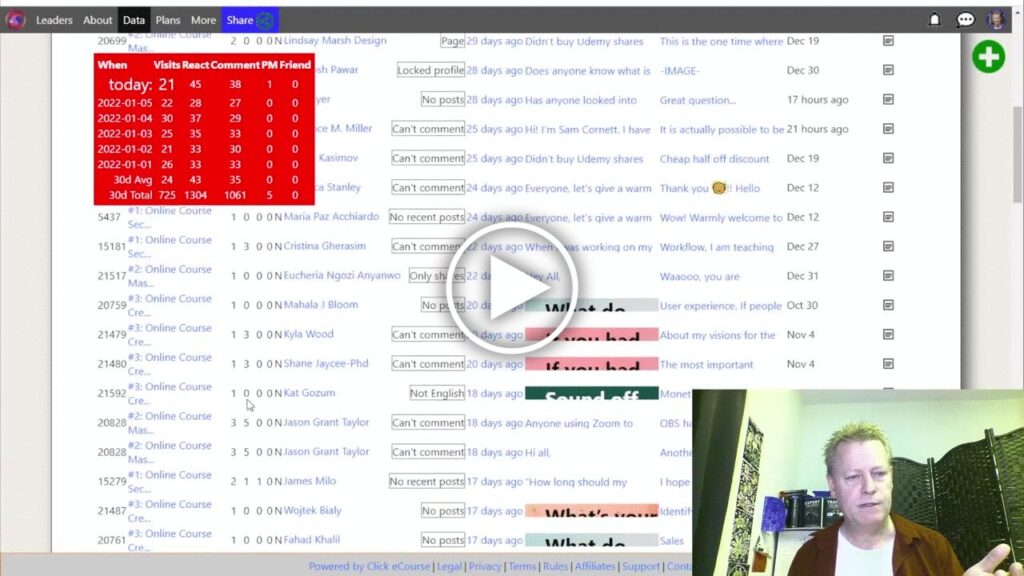How to find Active Users in any Facebook group?
You might be thinking it’s easy to find who is active in Facebook groups.
I certainly thought it was too until I understood how to really do it.
Sure, you can go to a group and look at who’s posting, commenting and reacting each day and that will give you who is active for that day.
Actually, that’s how I started doing it but it didn’t take long for me to get discouraged.
Why would you want to know who’s active?
Before getting into the reasons why I got discouraged, let’s talk about the reasons why you might want to know who’s active.
You might want to know who is active:
- To learn who is helping you grow your group
- To know who to engage on
- So you can send them a friend request
- Because you want to have conversations with people who you can know first (by checking their posts)
- So you don’t waste your time messaging or friending people who haven’t used Facebook in months
Personally, right now, I want to know who’s active in Facebook groups so I can get them to know me.
How does it help to get them to know you?
Maybe you are surprised as to how it could possibly help them to get to know you!
I mean, how can that be – you’re just finding who they are – they don’t know you, right?
Well, what I do is engage on their profile posts which causes Facebook to notify them and they see me in there.
After doing it for a while, they start to know me.
But anyway, more on that in other posts, such as Course Income Secrets #381 – How to get leads and sales with Notifications on Social Media?
How do you really know who is active in a Facebook group?
The first thing you need to do is, as mentioned above, go to the group and see who is posting, commenting and reacting.
That’s easy enough, right?
The problem is that even if they took action today doesn’t mean they are really active – it just means they are active today.
So, what you need to do, is do that every day for a month and keep track of all that to get numbers like posts per month, comments per month, reactions per month (for example)
Sounds simple enough, right?
Why is it so hard to do this simple task?
Actually, it’s not that hard to do, it’s just much more time consuming than you’d think.
Take a moment and think about it… how could you track every post and correlate it to the users who already posted?
You’d have to use a spreadsheet or folders to track it all.
It didn’t take much more than a few days for me to get discouraged because of the sheet amount of manal work to do this!
Imagine a group with 1000 members for example – there’s probably 100 that post once a month, 20 that post every other day and 10 that are active every day.
How do you find them?
Only way to do it is with a tool
If you value your sanity or your time, you know that you need to have a tool that does this for you.
There are lots of options out there, but I’m crazy and like to create my own tools so you can use it too.
A while back, I created a Chrome Extension called Active Group Users.
It basically lets you scan any group you are a member of for the active users in that moment.
Once you have that data, you can save it to a Google Sheet and each day see who is active.
There’s still some manual work involved (for now) but it’s a lot easier that doing it all manually.
Using Active Group Users Chrome Extension
You can install the chrome extension from the Chrome store (go to http://download.activegroupusers.com)
Once you have it installed, follow instructions to activate your account.
Add the Facebook group(s) you want to scrape for active users and click the Start button in the extension popup.
From the data page, you can download the CSV file to get all the data.
Do this each day and start to build a list of when people are active.
After a while, you’ll know who is active each day, who is active more than 10 times a month and anyone else is just not active enough.
Conclusion
As you can see, how to fine active users in any Facebook group isn’t super complicated but it does take time.
You probably could just go to Facebook and navigate around for hours to get the data but using tools is the most efficient way of course.
Watch the video to see hands on how to do all this.
Don’t forget to share this with your network by clicking the icons.
